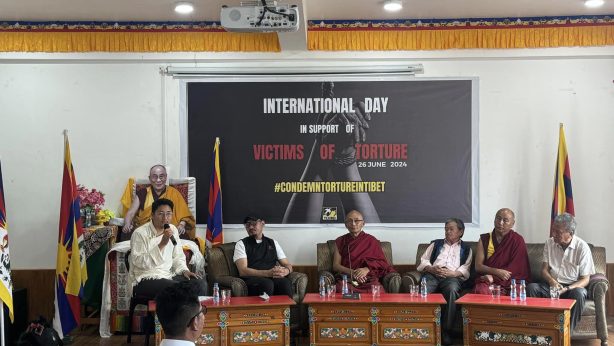Over 3,993 monks and nuns expelled: religious repression continues in Tibet
In its recently released report entitled “Closing the Doors: Religious Repression in Tibet”, the Tibetan Centre for Human Rights and Democracy (TCHRD) reported the expulsion of over 3,993 monks and nuns from their monasteries and nunneries under China’s “Strike Hard” Campaign. The report documents widespread repression of freedom of religion in Tibet ever since the launching of the “Strike Hard” campaign in Tibet in April 1996.
The principal part of the report is based on testimonials gathered in interviews with Tibetan refugees who have arrived in exile since 1997. The core of China’s “Strike Hard” and “re-education” campaigns is to force the monks and nuns to oppose notions of Tibetan nationalism and to denounce the Dalai Lama. Those who refuse risk severe repercussions. As of February 1998, 3,993 monks and nuns were expelled from their monasteries or nunneries, 294 were arrested and 14 deaths have been reported. Six monasteries and nunneries were completely closed down.
In addition, since the publication of the report, TCHRD has learned of the closure of Rakor Nunnery in Toelung Dechen County. This nunnery, situated 12 kms from Lhasa and which accommodated 80 nuns was shut down following the entry of Chinese”work-team” members to conduct “patriotic re-education” sessions on March 17, 1997. All the nuns were expelled following their refusal to comply with the instructions of the “work-team”. An integral part of the “Strike Hard” campaign in Tibet is its attendant”patriotic re-education” drive which has drastically suppressed religious freedom in monastic institutions. Chinese “work-teams” have been sent into monasteries and nunneries in all parts of Tibet to forcefully “re-educate “monks and nuns in how to think and act.
Those who resist face punishment in the form of expulsion or arrest. Tibetan monks and nuns are required to sign a five-point political pledge namely: to oppose the idea of an independent Tibet; to denounce the Dalai Lama; to recognise the Chinese-appointed Panchen Lama; to oppose those advocating independence of Tibet; and to work for the unity of the “motherland”. “Since the launching of the so-called Strike Hard Campaign in Tibet by the Chinese authorities, TCHRD has been monitoring the implications of this campaign” said Mr. Lobsang Nyandak, the Executive Director of the Tibetan Centre for Human Rights and Democracy. “The motive of launching this campaign in China and in Tibet is totally different. In China, the official aim of this campaign is to crack down severely on general crime and end corruption practices.
However, in Tibet the motive is to intimidate and eliminate those supporting Tibetan independence and human rights activists in Tibet. It the on-going “Strike Hard” and “patriotic re-education” campaigns remain unabated, they will bring about a total annihilation of the Tibetan culture and religion. This is evident from the scale of damage caused so far.”According to China’s own statement some 30,000 of Tibet’s 46,000 Buddhist monks and nuns have received “re-education” and that 1,780 of Tibet’s 1,787 monasteries and temples have been covered by the work teams.
Prior to China’s 1949 invasion of Tibet, there were over 6,000 monasteries throughout the country accommodating around 600,000 monks and nuns. By 1979 only 13 monasteries survived, and most monks and nuns had either died or been forced to disrobe. The Chinese authorities have been targeting novice monks and nuns in particular. Entrance to monasteries and nunneries has been denied to those aged below 18 years and as of February 1998, 937 novice monks and nuns have been expelled since the beginning of the campaign.”China is out to quash the existence of Tibetan monks and nuns as it believes that Tibet’s strong religious traditions fuel the Tibetan resistance movement. As of December 1997, of the 1,216 currently known political prisoners in Tibet, 837 were nuns and monks, comprising nearly 70% of current political prisoners” said Mr. Lobsang Nyandak.
The first wave of restrictions was the ban on the display of pictures of the Dalai Lama. The ban was announced in all the leading Tibetan newspapers on April 15, 1996. By November 1997, the drive to eradicate the influence of the Dalai Lama had escalated to the level that Raidi, Executive Deputy Secretary of the “TAR” Party Committee, announced on Chinese regional television that “we must declare a total war, in thinking and theory and in the ideological realm, on the Dalai Lama and his separatist force. “The “re-education” campaign was further extended in December 1997 when Chinese officials announced a new drive to eliminate the “influence of the Dalai Lama from the Tibetan masses” within agricultural communities, towns,cities, government organisations and schools. The head of the Tibetan Ethnic Religious Committee declared, “if the patriotic re-education is carried out only in the temples then the instability will continue.”
Source: http://www.radioradicale.it/


